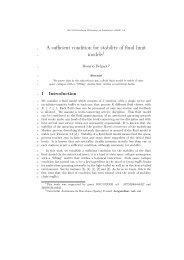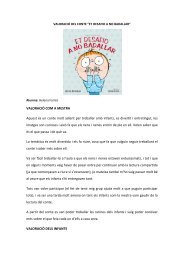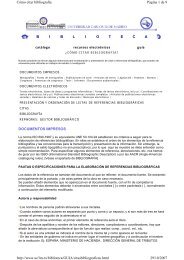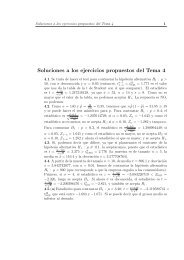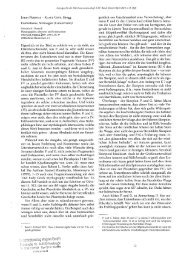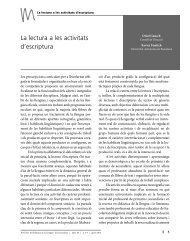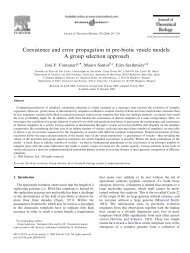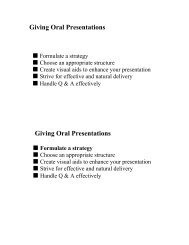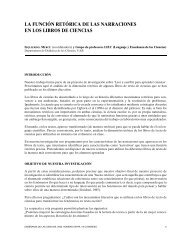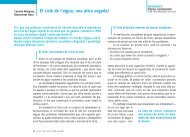please do not cite without permission from the authors
please do not cite without permission from the authors
please do not cite without permission from the authors
Create successful ePaper yourself
Turn your PDF publications into a flip-book with our unique Google optimized e-Paper software.
Among <strong>the</strong> questions which most worry governments in <strong>the</strong> region are <strong>the</strong> lossof fiscal revenues 19 and <strong>the</strong> resulting reduction of resources in <strong>the</strong>ir respectivepublic sectors, as well as <strong>the</strong> fear of confronting more competitive Europeanproducers in various sectors, even though <strong>the</strong> speed of liberalization may beslower for goods regarded as more ‘sensitive’.In this respect, <strong>the</strong> sharp differences in competitiveness and productivediversity between <strong>the</strong> EU and SADC are a central <strong>the</strong>me. The figures belowshow clearly <strong>the</strong> large inequalities of this kind between most countries in <strong>the</strong>two regional groups, which is a warning of potential asymmetry in <strong>the</strong> sharingof costs and benefits of market liberalization for <strong>the</strong> two sides.From Figure 4, which illustrates comparative competitiveness, 20 we see thatmost of <strong>the</strong> European economies are in <strong>the</strong> lower left quadrant, <strong>the</strong> bestpositions of <strong>the</strong> two rankings being for Sweden, followed by o<strong>the</strong>rs such asGermany, Finland or Denmark. On <strong>the</strong> o<strong>the</strong>r hand, most of <strong>the</strong> SADCcountries are in <strong>the</strong> upper right hand quadrant which means a low score forboth indicators, <strong>the</strong> worst countries being Zimbabwe and Angola. In <strong>the</strong> lowerright-hand quadrant are economies with a higher score for efficiencyenhancers than for basic requirements. Here South Africa is exceptional,occupying 42 nd place for efficiency enhancers and 79 th place for basicrequirements. In <strong>the</strong> upper left quadrant is Namibia, which, although it is wellsituated on basic requirements (54 th ), is as low as 91 st in efficiency enhancers.Finally, a <strong>not</strong>eworthy SADC country is Mauritius, which has a good score onboth indicators.19 A useful example is <strong>the</strong> case of <strong>the</strong> members of <strong>the</strong> SACU customs union, known as BLNSplus South Africa. These countries had to adapt <strong>the</strong>ir tariffs as a result of <strong>the</strong> TDCA agreementbetween <strong>the</strong> EU and South Africa. Various studies estimated at <strong>the</strong> time that <strong>the</strong> loss of fiscalincome for <strong>the</strong>se countries would be: Botswana 5.3 percent, Namibia 8.6 percent, Lesotho12.9 percent and Swaziland 13.9 percent. The search for alternative government revenues insuch circumstances is <strong>not</strong> always easy. The risk that it will weaken <strong>the</strong> state’s ability to supplybasic services should be taken into account (Goodison and Stoneman, 2005).20 The World Competitiveness Index is composed of <strong>the</strong> weighted means of <strong>the</strong> following 12indicators: institutions, infrastructure, macroeconomic framework, health and primaryeducation, higher education and training, efficient markets, efficient labour market,development of <strong>the</strong> financial market, technological disposition, market size, corporatesophistication and innovation. The first four (competitiveness 1) are grouped under <strong>the</strong> title ofbasic requirements, <strong>the</strong> following six (competitiveness 2) under efficiency enhancers and <strong>the</strong>last two under innovation and sophistication factors. For more information on <strong>the</strong> rank andvalue of <strong>the</strong> index for EU and SADC countries see Annexe 2 (WEF, 2010).16




